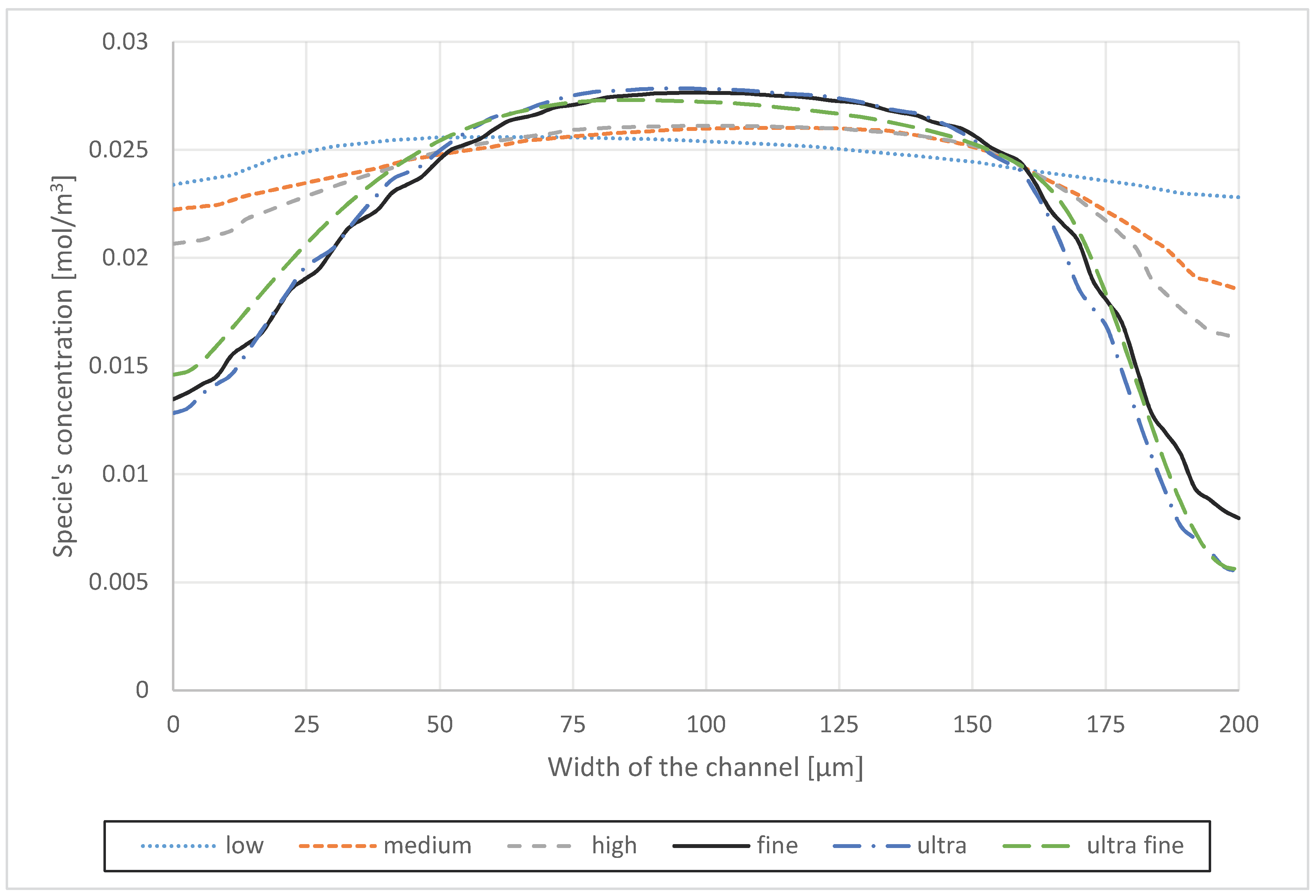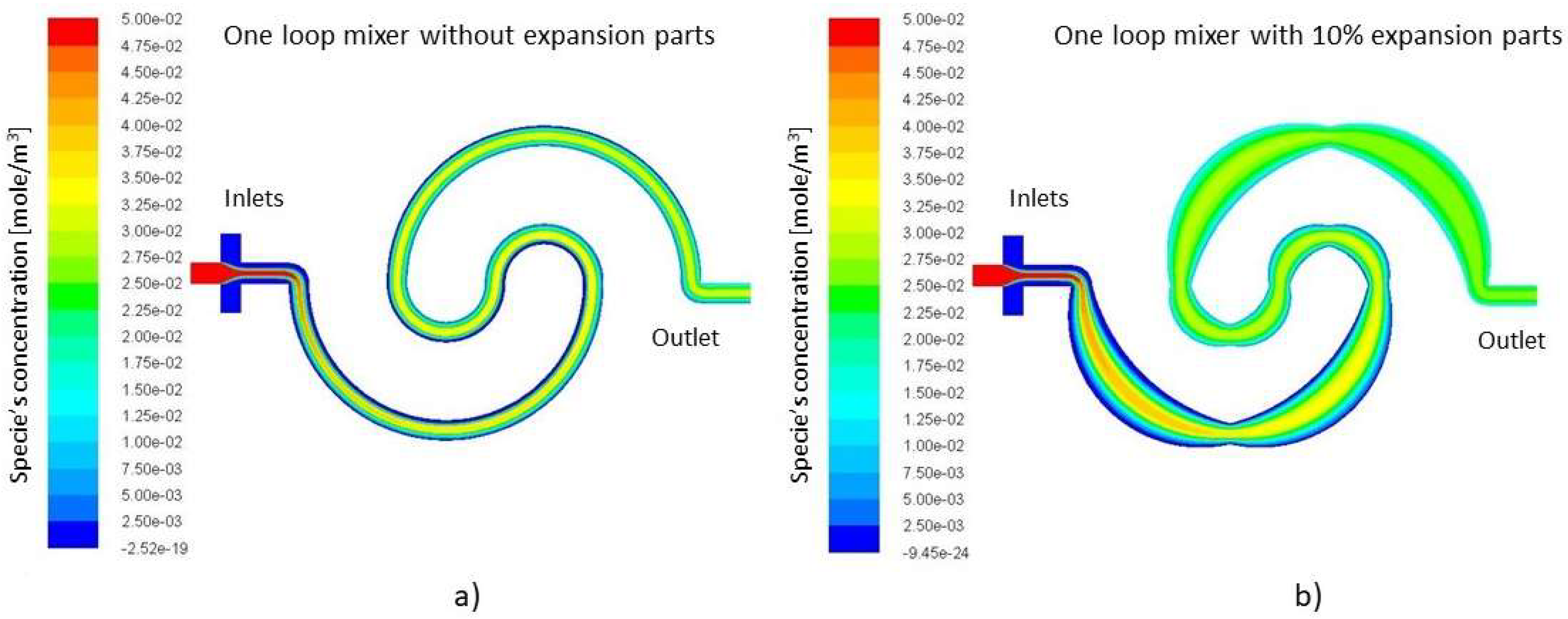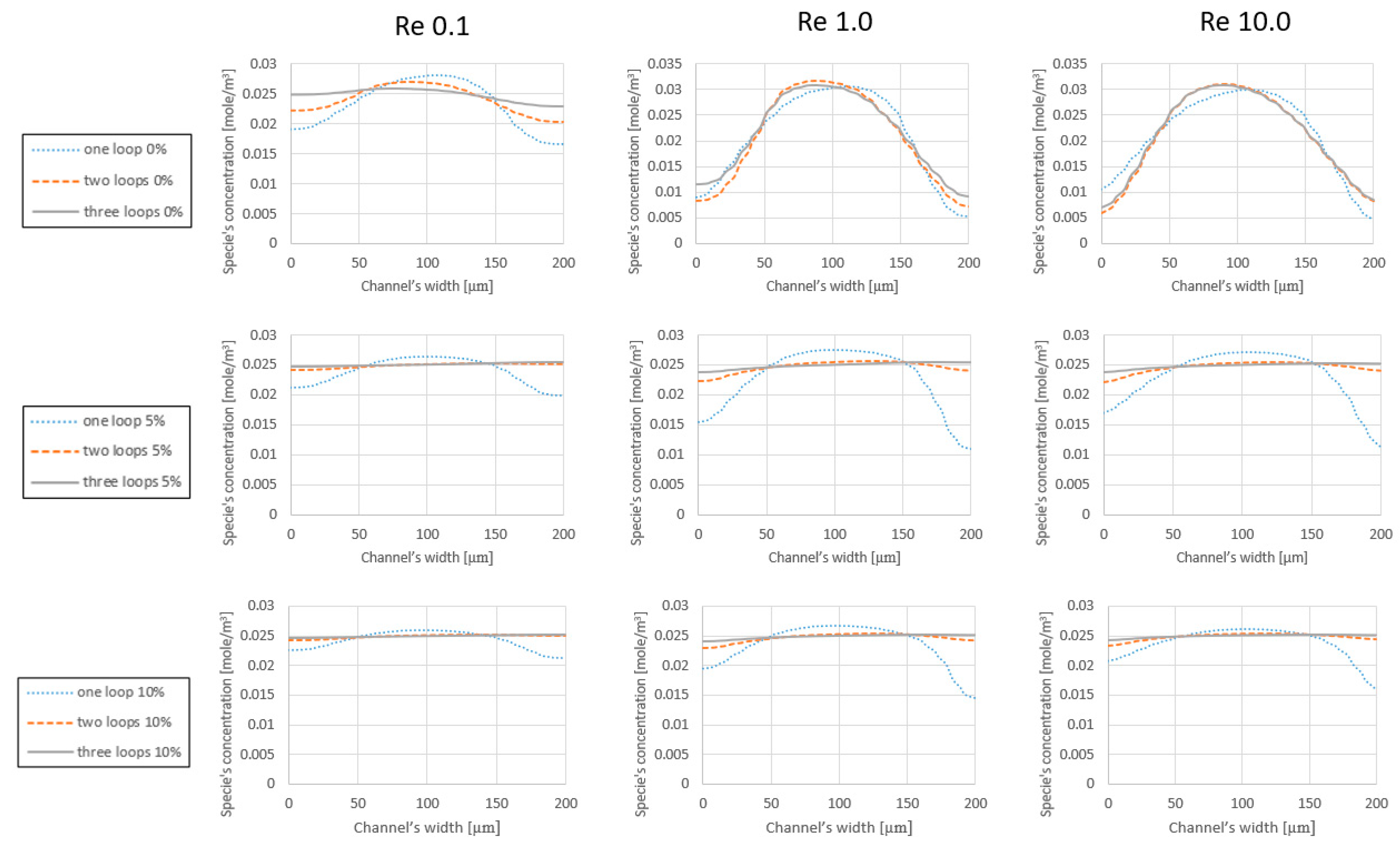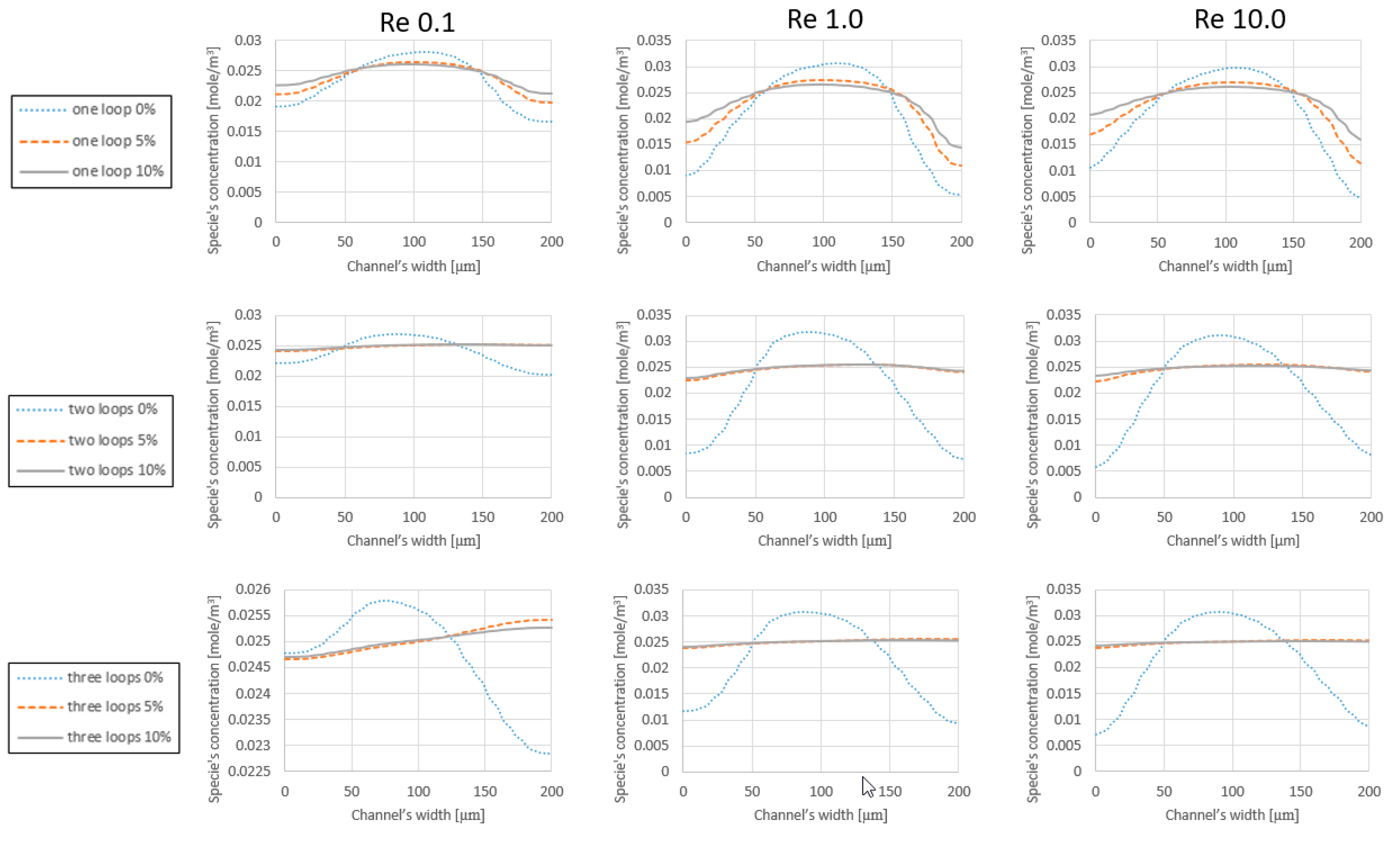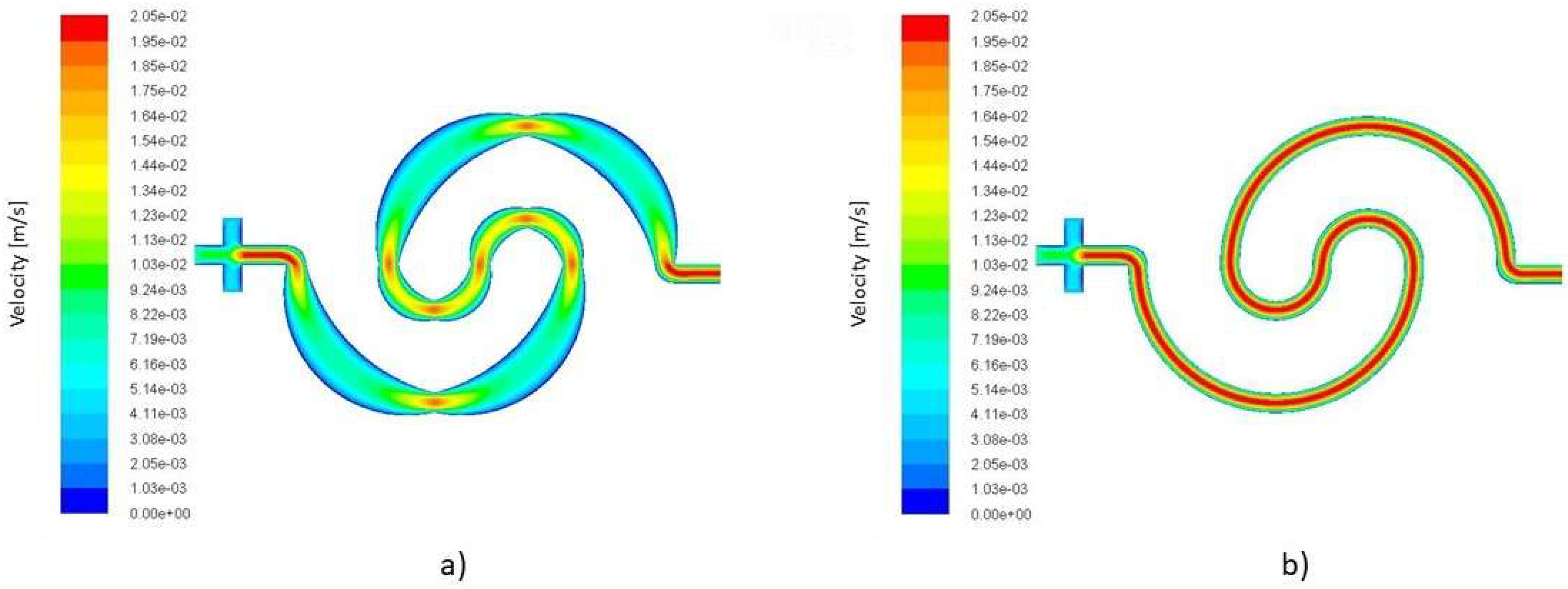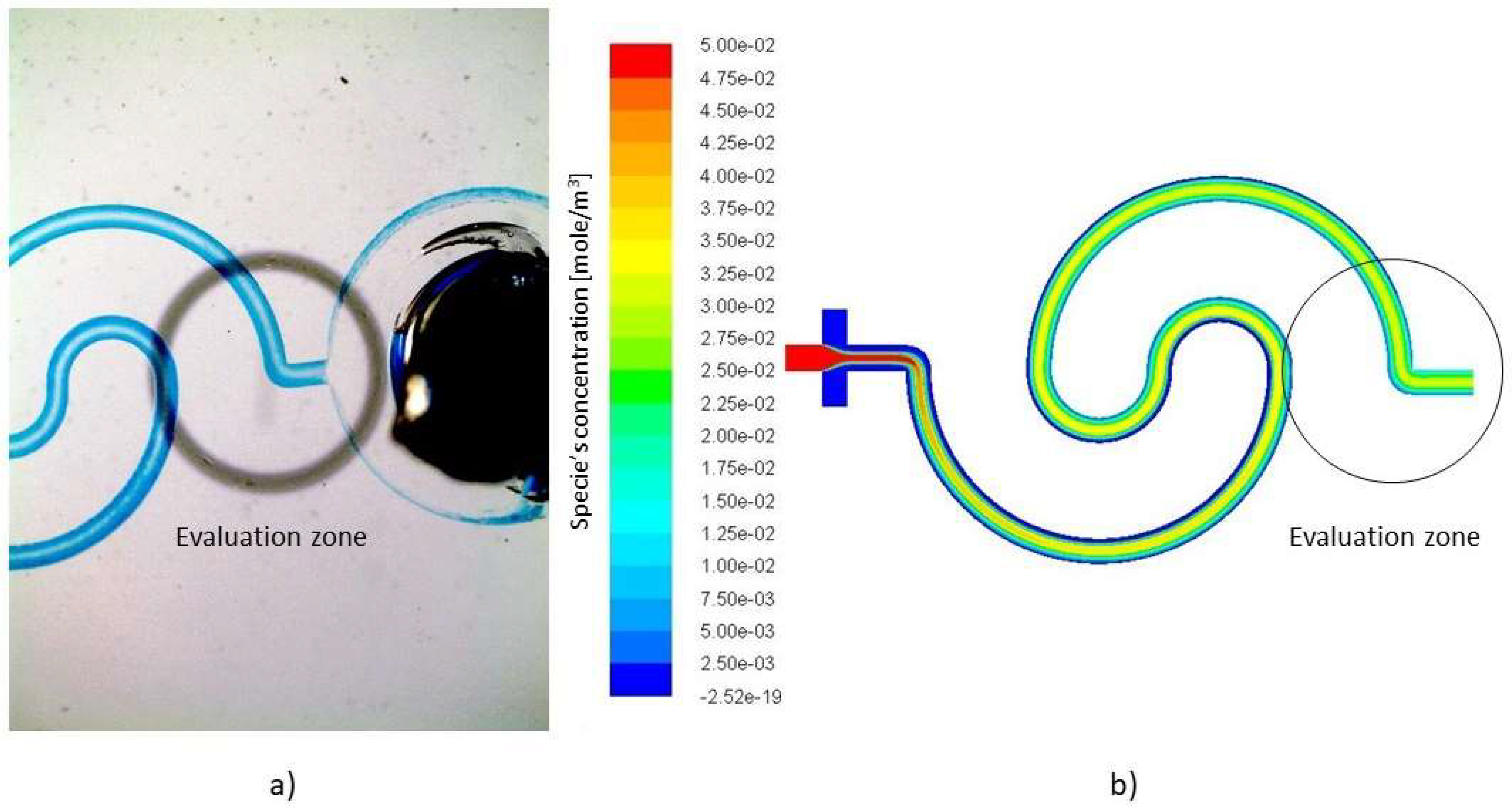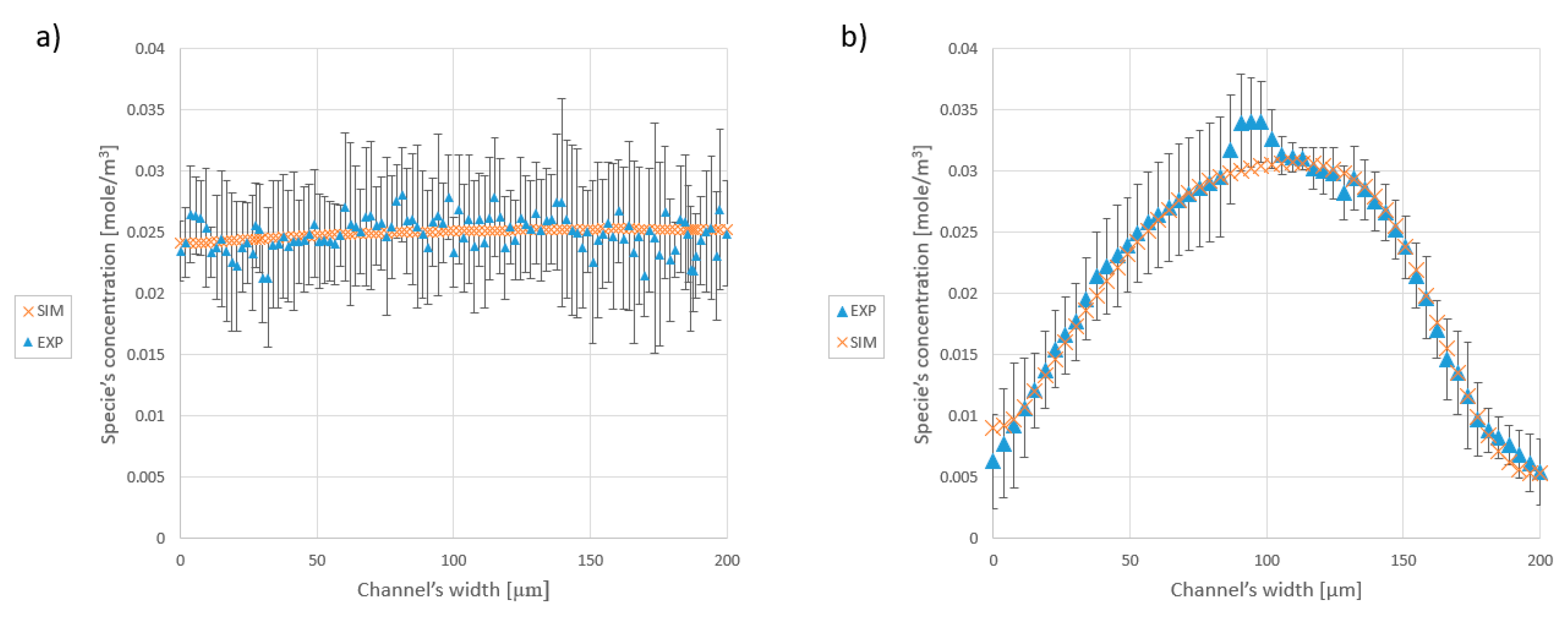1. Introduction
Microfluidics has opened new horizons in the biological fields [
1], such as single cell study [
2,
3], drug discovery [
4], lab-on-a-chip (LOC) and especially in point-of-care testing devices (POCT) development [
4,
5,
6]. Microfluidics capabilities in flow cytometry has led researchers to conduct assays on evaluating the deformability of cells and permeability of drugs through certain membranes [
7,
8]. Besides, the controlled nature of the microfluidics has provided the possibility of sorting and sequencing of cells [
9,
10]. In recent years, development of point-of-care testing devices (POCT) by deployment of lab-on-a-chip (LOC) technology has been found to be noteworthy by the researchers [
11]. Reducing the laboratory works and costs, rapid and accurate respond, providing bedside analysis and being user-friendly have been the most well-known characteristics of these devices [
11,
12]. Micromixers are one of the most important components of such devices. They have proved their efficiency in achieving objectives such as sample preparation, glucose concentration detection, blood plasma mixing, particle concentration detection etc. [
13,
14].
At high Reynolds number flows, mixing can be enhanced through secondary flows, chaotic advection and Dean vortices, but in microfluidics (laminar flows), mixing relies on diffusion. Therefore, according to the method used to maximize the mixing, micromixers can be classified as active or passive. Active micromixers require an external energy source to stimulate the perturbations in the flow, such as vibrations, and acoustic and electromagnetic stimulations. Passive micromixers do not require an external energy source and hinge on geometrical features of the design for providing a well-mixed mixture [
13,
14].
A lot of research has been conducted on optimizing the mixing phenomena in micromixers. Some researchers have engaged the features of both types of micromixers in one device. Afzal et al. [
15] investigated the effect of combining pulsatile flow and a bulb-shape geometry on the efficiency of the mixer. In a similar approach, Silva et al. [
16] carried out an investigation on a hybrid generation of micromixers, where variable inlet widths were coupled with the pulsed flow. Other researchers focused on the advantage of chaotic advection. For instance, Hermann et al. [
17] studied the mixing in three types of split-and-recombine (SAR) micromixers. In the proposed mixers, the 3D structure of the micromixer provided the chance for the flow to split and twist and recombine with the initial flow from another side. Raza et al. [
18] showed that a split-and-recombine micromixer with a 3D structure was able to provide high-quality mixtures at Reynolds numbers higher than 30. Chen et al. [
19] compared a 3D split-and-recombine micromixer with an in-plane T-mixer and showed the improvement of this method against the simple in-plane mixer. Although hybrid and 3D generation of the mixers are able to provide mixtures with promising homogeneity, the complexity of fabrication and the increased pressure loss practically restricts the applicability of such devices in the development of lab-on-a-chip (LOC) devices and point-of-care tests (POCT).
In planar mixers, researchers mainly follow the increasing contact surface (for low Reynolds number regimes) or induce chaotic advection (for high Reynolds number regimes) to improve the mixing. Julios et al. [
20] studied a planar mixer with perpendicular rectangular grooves on the straight microchannel. Alam et al. [
21] also performed a similar investigation on the effects of adding rectangular grooves on a curved microchannel. Both studies provided acceptable results, especially on Reynolds number regimes higher than 60. Li et al. [
22] studied the impact of putting obstacles on the path of the flow and showed that the placement, size and the angle of the obstacles can determine the performance of mixers in the range of 1 ≤
Re ≤ 10, but in higher flow rates the configuration of the obstacles does not play such an important role. Chen et al. [
23] included a pattern of pillars in the flow path of the micromixer. The study clarified the relation between the Peclet number and the mixing efficiency. The microchannel with obstacles (higher Peclet number) translated into a higher efficiency mixer. Rahman Nezhad et al. [
24] showed that deflecting flow with baffles could be a simple answer for acquiring relatively homogeneous mixtures, when the facilities are not advanced enough to fabricate sophisticated geometries. A study on the combination of gaps and baffles were conducted by Xia et al. [
25]. The results showed that the micromixer was able to provide mixtures with significant uniformity at very low Reynolds number (
Re < 1) and also at high Reynolds numbers (
Re ≥ 40).
An alternative approach analyzed the effect of the geometry and working condition on the flow behavior. Hossain et al. [
26] evaluated the mixing phenomena in three planar micromixers in a wide range of Reynolds numbers (0.267–250). This study showed that even though at the Reynolds numbers range of 20–100 the square wave channel provided the highest quality mixture compared to zig-zag and curved channels, at higher Reynolds numbers, the performance of the three mixers was almost identical. Khosravi Parsa et al. [
27] investigated the mixing efficiency in a sinusoidal micromixer with respect to the ratio of amplitude to wavelength. The study concluded that at high Reynolds numbers, the geometry of the mixers with higher amplitude and smaller wavelength allowed the Dean vortices to develop in the peak zones. This was later translated into better mixing compared to the other models. Vatankhah [
28] evaluated the effect of the channel’s cross-section dimensions on the velocity profiles in the channel. An accordion shape micromixer, which is an amended derivation of a zig-zag microchannel, was studied by Cosentino et al. [
29]. Their study evaluated the characteristics of the proposed device, with respect to the biological applications and limits. The study indicated that not all the current mixers are suitable for biological and biomedical research, since they cannot provide sufficient mixing and support vital living conditions for cells. Researchers have addressed the problem of providing high quality mixtures at very high or very low Reynolds numbers. The low Reynolds number range (0.1 ≤
Re ≤ 10.0) is the Achilles ankle of micromixers and in all the references the lowest quality is reported in this domain. Moreover, the pressure drop has always been sacrificed in order to achieve a high quality mixture. However, an increased pressure drop might mean increased surface tension, which could damage or modify living cells.
The purpose of this paper is to introduce a micromixer suitable to be mounted on POCTs and LOCs. Since in these applications the Reynolds number is low, diffusion is considered as the main mixing mechanism, and the proposed design enhances the contact surface with a reduced pressure drop to provide tolerable conditions for living cells. The approach used in this study aims to enhance the residence time by enhancing the mixing phenomena using a novel planar spiral shape micromixer with expansion and contraction parts. The purpose of these expansions/contractions is to enhance the diffusion length and modify the velocity profile. Nine different mixers (one-loop, two-loop and three-loops without expansion, with 5% expansion and 10% expansion) have been used in this study to predict an improved performance in the critical working range of Reynolds numbers 0.1 to 10.0.
3. Experimental Section and Fabrication Process
3.1. Fabrication of the Micromixer
Microfluidic mixers can be manufactured following different processes, varying from CO
2 laser ablation to 3D printing techniques. The present investigation uses the soft lithography technique [
31]. In this method, a cover glass slide is coated with photo-resist SU-8 (thickness 5-27 μm @GERSTELTEC SARL, Pully, Switzerland) to create a mold with the height of 25 μm. By placing a negative film of the micromixer and beaming UV light on it, the geometry of the device is defined in SU8. The mold fabrication process finishes with sinking the defined pattern in the SU8 developer (PGMEA—Propylene glycol methyl ether acetate @GERSTELTEC SARL, Pully, Switzerland) and cleaning it with propanol. Then, a 10:1 mixture of Silicone Elastomer SYLGARD 184 (@Dow corning, Midland, MI, USA) and its curing agent are poured on the mold, which previously is coated with chlorotrimethylsilane vapor. After baking the polydimethylsiloxane (PDMS) and removing the PDMS from the mold, the connections are created. O
2 Plasma (@Gambetti Vacuum Technology, Binasco (Milan), Italy) is used to bond the hardened PDMS and a cover glass slide. Further precise measurements showed that in some mixers a maximum fabrication error of 2 μm in the width of the channel and 1.5 μm in the height of the channel was occurred.
3.2. Experimental Setup
To generate the flow, two syringe pumps (Graseby 3200- @Smiths, Watford, Hertfordshire, UK- and kdScientific 410-CE- @kdScientific, Holliston, MA, USA) were used. Deionized water and food colorant (a solute of deionized water and food coloring -E133- with the ratio of 2:1) were used as the working fluids. According to the analysis, actual differences of the density and viscosity of the working fluids were negligible. The syringe pumps’ calibration was verified by filling a 5-mL container in a determined time, where the container’s volume was graded by 0.1-mL lines.
The images of the unmixed and mixed fluids were captured using a Leica microscope (LEICA EZ4D- @Leica, Wetzlar, Germany), with 30× magnification. The microscope was equipped with lights that are able to beam on the top, side and the bottom of the device. The software of the microscope renders the image, varying from black and white view (0% of color saturation), normal view (100% of saturation) and exaggerated view (200% of saturation).
3.3. Image Analysis
Analysis based on images has been widely used in science. It is one of the most common methods to visually illustrate the results of the study. This method has a wide application varying from particle locating and tracking [
32], to showing the lysis of cells and to the evaluation of the mixture quality [
5].
In this study, pictures obtained of the mixing process are evaluated using ImageJ 1.51k software (National Institutes of Health (NIH), Bethesda, MD, USA). This software analyzes the features of a specified zone or line. In the evaluation process, the pictures are converted to grey scale (through RGB (Red, Green and Blue lights) analysis) and each pixel intensity is evaluated between 0 and 255. To reduce the noise influence, multiple analyses of the same zone from different pictures are carried out, and an average value is obtained as the foundation of the results. Notably, the standard deviation of the analysis is considered as the error range at each pixel.
Furthermore, experimental uncertainty in this work is highly influenced by the image processing section rather than gripping to the established boundary conditions. The results of image analysis showed that the intensity of light in the background varies from center to the corners and in the places where the light intensity was relatively lower compare to the center, higher noise was recorded in the RGB analysis. Background noise due to polarization and light breakdown, when it passed through the cover glass, PDMS layer and microscope lens, was obvious. For tackling this problem, it was decided to manually define a circular zone in the center of the photo capturing area in order to make sure that the minimum and maximum values of grey scale index are the same in the circle for all the experiments (Dettmer et al. [
33] followed a similar process with software for reducing the background noise). This procedure proved to be useful as the reported noise dropped significantly.
5. Conclusions
The purpose of this study was to design an improved micromixer for low Reynolds regimes useful for LOCs and POCTs devices with high efficiency and low pressure drop. The results of this paper propose a variable radius spiral micromixer as an excellent candidate. This paper studies the performance of the proposed designs in the flow regime range of Reynolds number 0.1 to 10.0. The numerical analysis was validated experimentally at Re 0.1.
Therefore, according to the results, the homogeneity of the mixture at the outlet is improved by adding loops to the mixer at low Reynolds numbers. By increasing the Reynolds number to 1.0, the efficiency of the micromixers without modified geometry dramatically drops, while in the variable radius micromixers, the decrease in performance at this flow regime is negligible. Both designs improved their performance at Reynolds 10.
This work demonstrates that regardless of the number of loops, and at every given inlet flow, the performance of the variable radius micromixers improves by increasing the expansion rate. Combining a two loop or three loop micromixer with expansion and contraction parts achieves mixing efficiencies higher than 90%.
In addition, the proposed expansion and contraction parts decrease the pressure drop by more than 60%. This means that employing a two loop or three loop micromixer with expansion parts is a reliable choice in situations where it is required to ease the fabrication, provide a homogenous outcome, use the surface area efficiently and have a low pressure drop.

